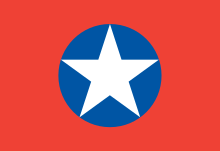Đại Việt Quốc dân Đảng
The Đại Việt Quốc dân Đảng ( ĐVQDĐ , Nationalist Party of Greater Vietnam ), known as Đảng Đại Việt ( Đại Việt Party ), was an ultra-nationalist , anti-French and anti-communist party in Vietnam . It was named after the medieval Vietnamese empire Đại Việt ("Great Việt").
The party was founded in 1938/1939 by law student Trương Tử Anh ( Anh Cả Phương ) as a militant underground organization against French colonial rule . Its goals were similar to the nationalist VNQDĐ , but politically it was even further to the right. Most of their supporters came from the educated upper middle class Tonkins , with Northeast Vietnam representing the party stronghold from the Hanoi area to the Chinese border area. The party was initially just one of several Đại-Việt groups that were formed in the late 1930s and early 1940s. All of these groups shared a similar ideology, in which progressive “ Young Turkish ” nationalism mixed to varying degrees with fascism , social Darwinism and pan-Asianism with Japanese characteristics ; they rejected (from their point of view ineffective) parliamentarism, colonialism and communism equally resolutely. Other important groups were the Đại Việt Quốc Xã (“National Socialist Đại Việt”), the Đại Việt Duy Dân (“humanistic Đại Việt”) of the scholar Lý Đông A and the Đại Việt Dân chính (“Đại Việt of the real people”) of the influential writers Nguyễn Tường Tam . The later South Vietnamese President Ngô Đình Diệm and his older brother Ngô Đình Khôi also founded such a Đại Việt group ( Đại Việt Phục hưng Hội ), which, unlike the others, came from Central Vietnam and was dominated by Catholics.
During the Second World War , the VNQDĐ supported the Chinese Kuomintang against the Japanese ; the Đại-Việt groups, however, collaborated with the Japanese occupation forces and the pro-Japanese Prince C japanischenng Để . With their support, they were able to set up and arm their own paramilitary groups. Unlike the Việt Minh or the religious militias of the south, the Đại Việt never had a significant mass base, but remained numerically insignificant. At the end of 1944 there was a short-lived amalgamation of four Đại-Việt groups to form the Đại-Việt National Alliance ( Đại Việt Quốc gia Liên minh ). The Đại Việt finally became the mainstay of the imperial puppet government under Prime Minister Trần Trọng Kim in the spring of 1945 . In the course of the August Revolution , the Đại Việt were ultimately largely smashed by the Việt Minh in 1945/46 and a large part of the top management was killed.
At the beginning of the 1950s, the Đại Việt Quốc dân Đảng had successfully reorganized under French toleration and now supposedly had around 200,000 members. However, the party's paramilitary youth militia ( Thanh niên Bảo quốc Đoàn ) was linked to the suicide bombing of General Chanson and Governor Thái Lập Thành in the summer of 1951 and was therefore banned. Despite this incident and its general hostility to France, the party took part in the government of the pro-French state of Vietnam towards the end of the Indochina War and even temporarily appointed Phan Huy Quát as head of government in 1954.

After the division of the country, the party was active in South Vietnam . During the Diệm regime, it was one of the suppressed opposition parties. After his assassination, in which Đại Việt supporters were also involved, it was involved as an influential small party in several governments. In 1964, the party provided the deputy head of government with Nguyễn Tôn Hoàn and in 1965 with Phan Huy Quát the prime minister. Due to internal disagreements, the Đảng Tân Đại Việt split under Nguyễn Ngọc Huy in 1964 , followed by the Đại Việt Cách mạng Đảng the following year.
Since the fall of Saigon in 1975, the party has existed as an exile organization in California.
Individual evidence
- ↑ KW Taylor: A History of the Vietnamese , Cambridge University Press, 2013, p. 527ff
- ^ The Cao Đài and the Hòa Hảo
- ↑ Kim Khánh Huỳnh: Vietnamese Communism, 1925-1945 , Cornell University Press, 1986, pp. 297f
- ↑ Spencer C. Tucker: The Encyclopedia of the Vietnam War: A Political, Social, and Military History , ABC-CLIO, 2011, p. 253 (entry Dai Viet Quoc Dan Dang , but with the wrong date of foundation)
- ^ Joseph Buttinger: Vietnam: Vietnam at war , Pall Mall, 1967, p. 1244
- ^ François Guillemot: An Intellectual through Revolution, War, and Exile: The Political Commitment of Nguyen Ngoc Huy (1924-1990) ; In: Nathalie Huynh Chau Nguyen (Ed.): New Perceptions of the Vietnam War: Essays on the War, the South Vietnamese Experience, the Diaspora and the Continuing Impact , McFarland, 2015, pp. 41-71
